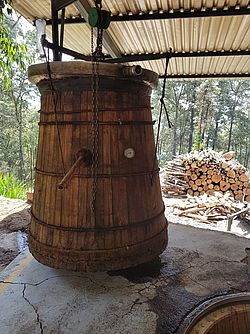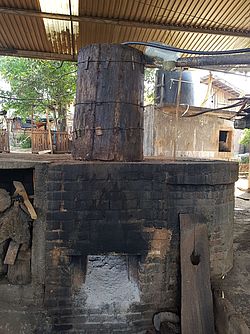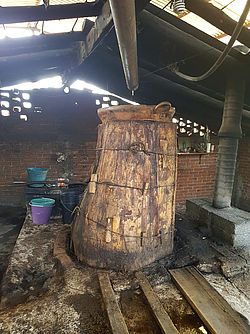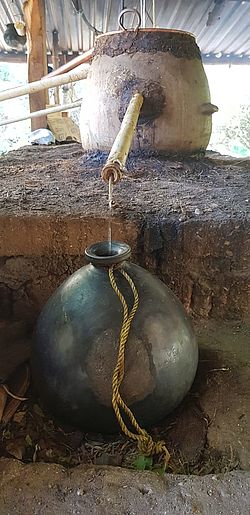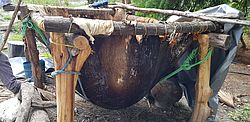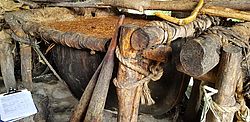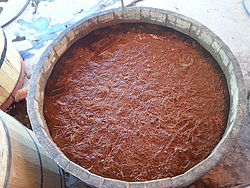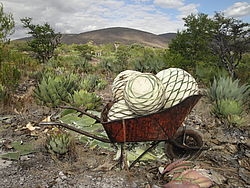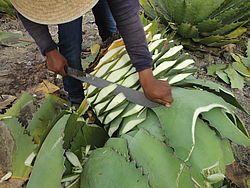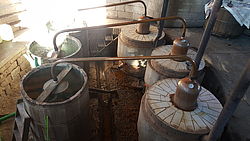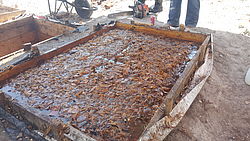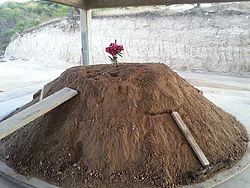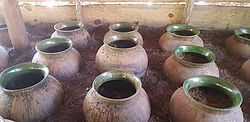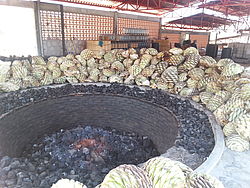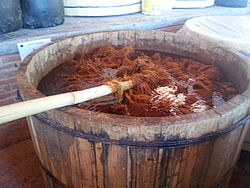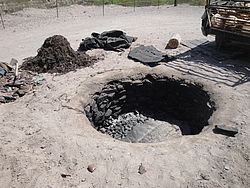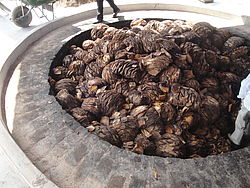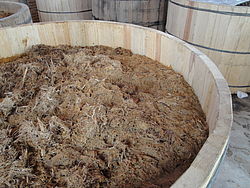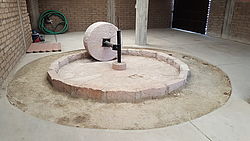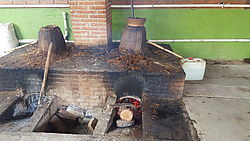In summer 2016, I applied for an internship in a spirits company in Mexico. My wife is Mexican and I wanted to get to know a different side of her country, so, instead of just going there for holidays, we wanted to dive into everyday life. The internship was the ideal opportunity to test the waters and find out whether we could see ourselves living in Mexico on a permanent basis. The experiment worked out very well and during my internship I was offered a full time position as Process Engineering and Projects Manager. Three years later, I am still with that same company.
While I was still studying in Geisenheim I talked to Professor Dietrich, who lectures on ‘spirits’, about my plans and together we came up with the idea of writing my final thesis during the internship. Even though Mezcal was included in the agave spirits section of the curriculum, at that time the beverage was only known to insiders. Nowadays several varieties of the spirit are available in bars and well-stocked liquor stores, even in smaller towns, and Mexico and agave spirits in general are very popular at the moment. In the United States, the Mezcal hype has reached the mass market; a year ago George Clooney’s Mezcal and Tequila company was sold for one billion US Dollars. With a thesis on Mezcal I had certainly tapped into a trend. I decided to focus on the following questions: What is Mezcal and how is it different to Tequila?
As luck would have it, I was offered an internship in a Mezcal factory in Puebla. The production site, called “Fábrica de Mezcal, Palenque or Vinata” had only opened a month before I started the internship, so I was lucky enough to be there from the start. Several times a week we took a long and often off-road ride from Puebla to a small village, with the goal of optimizing production, looking for potential in the individual process steps and finding solutions to technological problems. One important aspect was the training and communication with the factory staff: this combined traditional practice-oriented knowledge and innovative ideas from the Beverage Technology degree program. What I found most inspiring was that the staff’s empirical know-how was very similar to the technological know-how taught at universities. The only difference was that processes were described in a different way, but with regard to our skills, we were on the same level and there were many times when I learnt something new and saw things from new perspectives. During the internship, I had the opportunity to visit several Mezcal factories in Mexico and gained a good overview of the spirit and its production.
My supervisor, Doctor Iván Saldaña Oyarzabl, was very excited when I told him about my idea of writing my thesis on Mezcal. He wrote his PhD thesis on the biological mechanisms of the agave plant and is one of the few Mexican experts on Mezcal. This was when we decided on transatlantic cooperation with Professor Dietrich as supervisor and Doctor Saldaña as co-supervisor. With this unique cooperative approach I had the best support for writing about the magic of Mezcal.
Mezcal is a very diverse beverage, going far beyond the field of beverage technology. Most of the aspects that play a role in production are interdisciplinary, for example, there is the specific biology of the agave that influences the production process, as well as cultural-historic and social-religious aspects. There are only a few spirits that are connected in this way to the country where they are produced. While writing my thesis I found that these interdisciplinary factors are exactly the things that make Mezcal so special, but more about that later.
Mezcal is an agave spirit, and all varieties of the succulent plant, which belong to the family of asparagaceae, can be used for production. The plant grows all over the United States, but the greatest biological diversity occurs in Mexico. As far back as 11,000 years ago, Mexican people were cultivating and domesticating the plant, which also explains its diversity in Mexico. Contrary to the plant’s fruits, which contain sugar that mostly ferments immediately, the agave plant stores sugar for up to 25 years in the form of fructose polymers. These ‘fructans’ have the same purpose as starch and act as a store of carbohydrates for the plant. Their structure is just as complex, but instead of linked glucose molecules as found in starch, fructans are complex fructose polymers. Unlike with starch, sugar is not broken down by enzymes, but through a thermic process. The heart of the agaves (piñas) are mostly piled onto heated volcanic stones in a sort of cone-shaped earth kiln and earth and palm leaves are applied to the outside of the kiln, so that no air can get in. The agave hearts stay for up to 6 days in the kiln, exposed to constant heat, after which the kiln is opened and the piñas are not only softer, but the heat and steam has caused the fructans to break down, resulting in fermentable fructose sugar molecules.
Similar to the mashing process in beer production, the agaves are now very sweet (depending on the variety, sugar content is 10 to 30 brix). The earth kiln also contributes to the aroma: depending on the type of wood used, the agaves have a smokey flavor, with sugar caramelization adding another flavor component. The earth kiln is the most commonly used device for breaking down sugar, but there are also factories using steam-driven brick kilns or autoclaves, resulting in different flavors. Alongside the primary aromas of the plant (citrus, herbs and resinous aromas are typical) and the additional aromas of the thermic process (caramel and smoke), Mezcal’s fermentation also plays an important role. In contrast to wine and other fermented beverages, it is impossible to use commercially selected yeast, so usually, spontaneous fermentation is initiated or a spontaneous yeast base is injected into the plant. Many Tequila and Mezcal companies also conserve their very own yeast base for certain periods of time. It is mostly yeasts and bacteria that cause fermentation, leading to a specific aroma - the spectrum goes from interesting and complex to fermentation faults that lead to a slight taste of vinegar. Commercially selected yeasts only show little growth in the agave must because the essential oils in agave– similar to those of hops – have an antimicrobial effect, and also, must consists mostly of pure fructose, making metabolization difficult for beer and wine yeasts. For fermentation we mostly use wooden vats of 1 to 1.5 m3 but stainless steel, clay or plastic containers can also be used and in very special cases even cow skins. Due to the fact that Mezcal production was sometimes illegal, people used very simple materials so that it could be produced everywhere and without much effort; a hole in the ground for the earth kiln, cow skin as a fermentation container, and a distillation vessel were the only things needed for Mezcal production.
After the agave hearts are taken out of the earth kiln they are crushed using a stone wheel. We usually mix the juice with the fibres and water in the fermentation container, decreasing the brix value to between 10 and 14 °brix. Depending on the climate, spontaneous fermentation takes 4 to 12 days, but some factories ferment even longer. In the next step, the fermented must, called Tepache, is converted to raw distillate. For the conversion we use a copper distillation vessel, but there are also areas where clay distillation vessels are used, sometimes even with wooden helmets or other “rustic” elements, and, surprisingly enough, that works very well. There have been some historical finds of ceramic and clay objects suggesting that the indigenous people of Mexico were aware of the distillation process even before the arrival of the Spaniards. The raw distillate, also known as Ordinario, is processed to a fine distillate after the second burning process. The whole production process consists of several individual steps, and sometimes the distillates from each step – the first run is called Cabeza and the last one Cola – are separated during the Ordinario process. Only the distillate from the middle run (Corazón) is sold as Mezcal. In the past, it was common to sell directly from the barrel (> 60% vol.), but today Mezcal is bottled (min. 36% vol. to max. 55% vol.) and, in rare cases, wooden maturity barrels are used for storage.
This complex production process with its various options is also used for producing other agave spirits such as Tequila, Bacanora, Comiteco, Raicilla, and Tusca. For Sotol production, even though it comes from a different plant (bot.: Dasylirion spp. – dessert spoon) the process and the final product are very similar to the agave spirit and that is why I would include it in the list of agave spirits. Many regions create their own registered product names to gain a leading edge in marketing, even though for many centuries, the name Mezcal was used as a general description of the product. According to the regulations from 1949, even Tequila was called “Aguardiente de Mezcal”. Establishing a generic term, similar to ‘beer’ and ‘wine’ would help consumers to get their bearings. Special products such as Tequila could have a special status, comparable to the registered trademark Bordeaux, so that everyone would know that it is a Mezcal spirit. Unfortunately, there is more chaos than clarity with different sides fighting one another.
In the 70s Mezcal was mostly unknown to consumers outside the local market and at that time more than 1,200 Mezcal companies were registered, of which only a few managed to sell their own products. When the boom began a couple of years ago, the big spirit companies became interested in Mezcal production, and, in the meantime, more than 70% of the Mezcal market is owned by the 10 largest companies. In my opinion that development happened much too fast. Although Mezcal has become THE on-trend liquor worldwide, there are still too many unanswered questions. The Denominación de origen label (registered geographical denomination of origin) denotes an area larger than France with several different geographical regions and is only a political construct which does nothing to promote the interests of local producers, and the regulations are very industry-friendly and lack clarity. The Consejo Regulador de Mezcal, a committee responsible for implementing the regulations, cannot make decisions due to conflicts of interests. I fear that other countries will enter the conflict, threatening Mexican producers, and, added to this, the United States is the biggest market for Mezcal, even bigger than Mexico. The agave plant also grows there and they already have production sites, which makes the Mexican market even more vulnerable. There are however several possible steps that might strengthen Mexican producers: Scientific institutions are conducting research, which might also improve the political situation. Industry and research institutions are also working together on the implementation of local regulations, for example, in the fields of sustainable cultivation and waste disposal. I really hope that this unique liquor finds its niche in the global market and highly recommend you try it!
Jan Hendrik Giersiepen was awarded the enologist’s newcomer award 2018 for his thesis, entitled, “The spirit of Agave: Mezcal” in the field of beverage technology, supervised by Professor Helmut Dietrich.

